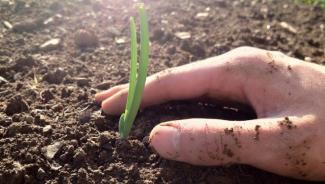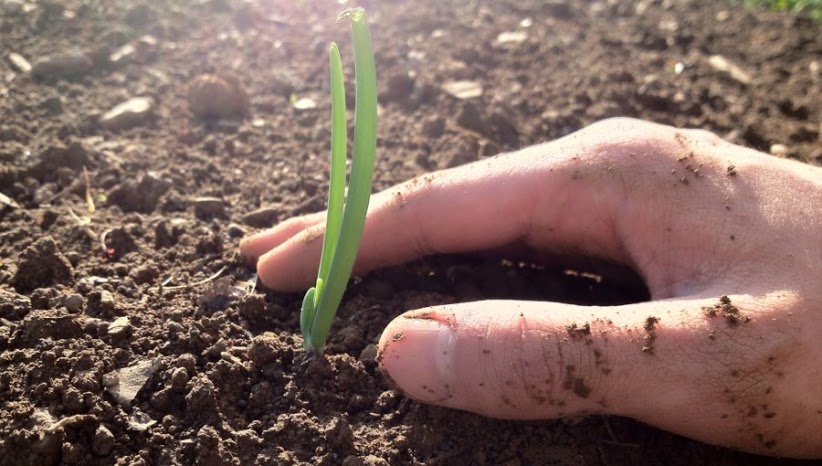Getting God's Word Inside You

 Their droopy eyes told me we were in for a long and listless afternoon. I was studying the Gospel of Mark with a group of fifteen college students at Campus by the Sea. Their late nights of singing around the campfire and sleeping on the pier were catching up with them—which meant they were less than alert in our morning session.
Their droopy eyes told me we were in for a long and listless afternoon. I was studying the Gospel of Mark with a group of fifteen college students at Campus by the Sea. Their late nights of singing around the campfire and sleeping on the pier were catching up with them—which meant they were less than alert in our morning session.
I was feeling disappointed and desperate because the passage for the day was the parable of the sower who scatters seed on four different kinds of soil (see Mark 4:1-20). It is a key linchpin passage for the book. The stories that follow only make sense when the truth of the parable is fully grasped. But how could I help my sleep-deprived friends engage the text?
During one of the breaks, I wandered up the canyon to the Campus by the Sea junkyard. As I prayed and poked around the scrap pile, I discovered a spool of telephone cable with strands of color-coded cooper wire. The week before, I had done a wire sculpture project with the third grade class at our church. There was a chance a similar approach would work with my college friends. I cut off a length of cable, removed the outer sheath, and took the colored strands of wire back to the seminar room.
Learning to Sculpt the Word
When the students sleepily returned after their break, I said, “I can see that you are all mentally tired. Rather than continue to study the passage inductively like we did this morning with our manuscripts, I would like you to try and engage the passage in a different way—artistically.”
Showing them the wire, I said, “Take a few moments to reflect on how the parable of the sower speaks to your heart. Then use this wire and create something that expresses how this passage speaks to you personally.” Then I sent them off, asking them to return in an hour so that we could share our creations with each other.
At the end of the hour they returned bearing their creations of rock, driftwood, and wire. It quickly became apparent that some had a knack for working with their hands, while others still had the dexterity of a third grader. But wire sculpture competency was not the goal. Engaging God’s Word at a deeper heart level was the objective.
I asked if anyone wanted to tell us about their work. The first to speak up was a young man who almost always wore black and rarely spoke. When he did, his comments were tinged with an edge of sarcasm. Using black wire, he had created a large crow with outstretched wings swooping down to pick up a small yellow seed. As he described the work, I sensed that he felt sad for the little seed and was a bit fearful of the crow.
His girlfriend spoke next. She had created a delicate orange flower with green leaves and a stem growing out of the crack in a rock she had found. Above the flower was a yellow sun shining down. The petals and leaves were all pointing down as if they were wilting. She had told me earlier that her parents were Christians and that she had gone to a Christian high school. But she was struggling now as a freshman in college.
When we got to the fourth presenter, it suddenly dawned on me what was happening. Each person had created themself in their artwork, and as they discussed their efforts, they displayed a level of vulnerability that I had not seen in the previous three days. The process enabled them to wrestle with the Scripture text and the implications for their own souls at a much deeper level. When that kind of thing happens on a consistent basis, the doorway to inner transformation is opened.
Learning to Chew the Word
Genesis 3 tells us that sin came in to this world through the act of eating a piece of forbidden fruit. Eating suggests taking something inside of us to digest and absorb it so that it becomes a part of us at a deep level. The book goes on to explain that the spirit of rebellion that our ancestors swallowed now ferments in the hearts and minds of everyone on the planet.
But Psalm 1 tells us that the person who is ultimately happy and at peace is the one who delights in the law of the Lord, and “on his law they meditate day and night.” The Hebrew word for “meditate” means to chew. Inductive study, Scripture memorization, lectio divina, and artistic reflection are all methods of chewing God’s word and getting it inside of us where it can do some good.
If we want to grow as followers of Jesus, it might help to think of God as a French chef running a fine restaurant rather than a short-order cook working at McDonald’s. The meals he personally and carefully prepares for us are meant to be eaten slowly and savored. Learning to savor God’s Word is not only good for our souls; it also honors the chef. Bon appétit!
Steve Stuckey has served with InterVarsity in California since 1971. He and his wife, Nancy, have three grown children and five grandchildren. You can see more of his work at www.stevenstuckey.com.



